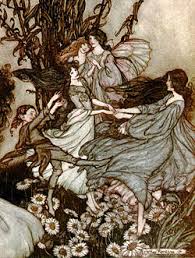
The fairies were thought to be particularly active under the light of the full moon. On those brightly illuminated nights fairies, who lived in beautiful palaces under the sea, were said to come up on to the land to revel and converse with the fairies of Ireland, at fairy mounds and around hawthorn trees, as Lady Wilde explains, ‘on moonlight nights they often come up on the land, riding their white horses, and they hold revels with their fairy kindred of the earth, who live in the clefts of the hills, and they dance together on the green sward under the ancient trees, and drink, nectar from the cups of the flowers, which is the fairy wine.’
As fairies and mortals lived separate but connected lives, the full moon presented greater possibilities of association between these two races. On Inishbofin, for example, dread of the fairies was so strong that when the moon was fullest, young girls were encouraged to stay indoors to avoid being abducted as brides to the fairies, while the good people’s* beautiful music and dancing was said to have tempted many a young girl to leave her home on these most ominous evenings. The full moon also presented an opportunity for the fairies to seek revenge on anyone who had slighted them, and anyone who built over a mound or cut down a fairy tree would do well to stay in on these nights for there are many stories that attest that the fairies took their opportunity to seek revenge on those mortals on moonlit evenings.
* When speaking of the fairies the name ‘good people’ was often used as a precaution to causing offence.
Sources
Lady Jane Wilde, Ancient Legends, Mystic Charms and Superstitions of Ireland, 1887
Lady Jane Wilde, Ancient Cures, Charms and usages in Ireland, 1890
See second verse:
http://www.celticlyricscorner.net/amhlaoibh/seoithin.htm
LikeLiked by 1 person
Wow very beautiful, thanks for the heads up Dominic
LikeLike
Reblogged this on thefadingyear.
LikeLike